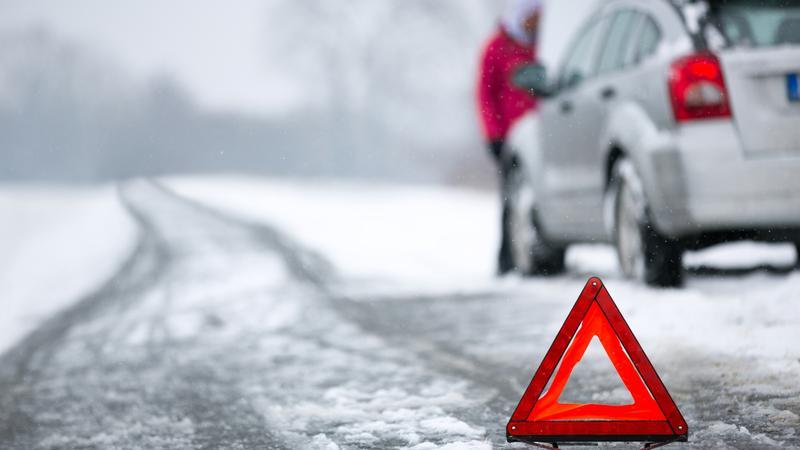This article has been updated from a previous version.
Many Canadians take winter weather in stride. But it’s not always business as usual. A study published in the medical journal, the Lancet Planetary Health, found that over the last two decades, there have been more cold-related mortalities than heat-related mortalities.
Factor in treacherous conditions like snow, black ice, and reduced visibility, and it’s clear that winter driving is a different matter altogether.
Here’s a plan for preparing yourself and your vehicle for winter driving:
Your winter car kit
If you’ve spun off the road, blown a tire, or your battery has died, be ready for a long wait to be extricated. There are some materials you should keep on hand in the vehicle for comfort and survival’s sake. These include:
- Extra layers of clothing and blankets. It’s not comfortable driving in a parka and snow pants, but you might want to pull them on if something goes awry — and the same goes for snow boots. Keeping warm is your priority, and you can’t just keep the engine running even if it still works — lethal carbon dioxide can build up, and an engine can overheat if the vehicle isn’t moving.
- A first aid kit. Your first aid kit should include items like sterile gauze pads (both small and large), adhesive tape, bandages, scissors, tweezers, safety pins, an ice pack, and antiseptic wipes.
- A flashlight and batteries. The days are shorter in the winter and it gets dark rather early; keep a high-quality flashlight and extra batteries with you.
- Food and water. Hopefully, you’re not going to be stuck on the side of the road too long, but if that happens, hunger and thirst can make you miserable. Keep some non-perishable snacks, like protein bars or prepackaged turnovers, to fend off the pangs. Calories also give your body something to burn to keep warm.
- Heat packets. Small packets that heat up automatically without requiring a power source can help keep hands and feet warm, especially if you can’t start the car for heat.
- A candle in a deep can will provide some warmth. Don’t forget the waterproof matches.
- A small shovel and a windshield brush. A folding shovel can help you dig your way out of a snowbank. A windshield brush is always needed to clear your windows of ice and snow.
- A Swiss Army Knife. Hopefully, you won’t be in circumstances where you need it, but a seatbelt cutter or a Swiss Army Knife might save the day. The Swiss Army Knife can be particularly useful with all its gadgets if you are stranded.
- A mobile phone. Did you need to be told that? Of course not. Nevertheless, make sure you have the appropriate numbers programmed and keep your device fully charged. Better yet, carry an emergency phone battery charger with you.
You can begin to assemble your emergency kit by downloading this list from the Government of Canada’s website and visualizing circumstances under which you’d need every item.
Other winter items to have in your car
These items don’t need to be immediately at hand. Some are too bulky or dangerous to keep in the cabin with you. Instead, keep these items in the trunk of the car to get it out of a snowbank if it’s stuck (if possible), or if it won’t start in cold weather, and secure the scene where you are to prevent follow-on accidents:
- Salt or sand, or even non-clumping kitty litter
- A tow chain or rope
- Battery booster or jumper cables
- Road flares
- Antifreeze, winterized washer fluid, and lock de-icer
Preparing your vehicle for winter
Don’t forget to winterize your vehicle before the season starts. Here are some things you should do:
- Install snow tires. According to the Tire and Rubber Association of Canada, 76% of Canadians switch to snow tires in the winter. Have winter tires installed when the temperature goes down to 7 degrees Celsius; that’s when regular tires start to harden and lose traction. Think about using a garage that will store your all-season tires for you if you don’t have a garage or basement. In Ontario, every auto insurance provider is required to give a discount to drivers who change to snow tires for the winter.
- New wiper blades. This is a minimal cost, but an immediate improvement in your driving experience. You should change your vehicle’s windshield wiper blades at least twice annually.
- Get a tune-up. Have all those belts and fluids and running parts refreshed and oiled before winter hits. Check fluids often, especially antifreeze and wiper fluid; you’ll go through much more of the latter in the winter than in the summer.
- Keep your gas tank full. Don’t let your fuel tank drop below half full. Do not carry an empty or full gas can in your vehicle, even in the trunk. Fumes could overcome you, and it’s a fire risk.
- Subscribe to a roadside assistance package. The Canadian Automobile Association (CAA) is synonymous with roadside assistance in Canada. But it’s no substitute for other preparations. Remember, if you’re in a spot because of the weather, so are other members. And CAA isn’t the only organization offering roadside assistance.
Be prepared for winter driving this year, and make sure you have the auto insurance coverage you need at a price that suits your budget.
